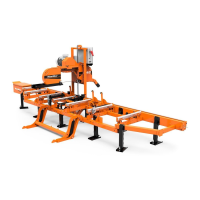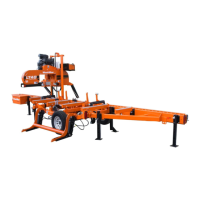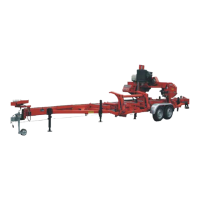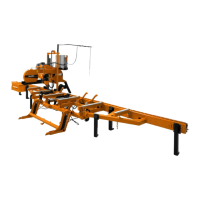
Do you have a question about the Wood-mizer LT30 Super and is the answer not in the manual?
| Brand | Wood-mizer |
|---|---|
| Model | LT30 Super |
| Category | Saw |
| Language | English |
Details model number, VIN, and customer number for service and identification.
Information on contacting Wood-Mizer for support, including contact numbers and office hours.
Detailed technical specifications for various sawmill models, including dimensions, weights, and engine data.
Explanation of danger, warning, caution, and important signal words and symbols used in the manual.
General safety guidelines and important notes for operating the sawmill safely.
Procedures and warnings for safely handling flammable fuels, oils, and lubricants.
Detailed steps for safely de-energizing the sawmill before maintenance or repair.
Instructions for preparing and anchoring a stationary sawmill on a firm, level surface.
Steps for setting up a portable sawmill, including outrigger adjustments and incline considerations.
Guide for safely removing and installing a sawmill blade, including tensioning and tooth direction.
Procedures for safely starting the sawmill's engine or motor, including pre-operation checks.
Step-by-step instructions for safely loading, turning, and securing logs onto the sawmill bed.
Explanation of how to use the up/down controls to adjust the cutting head height.
Instructions for engaging and disengaging the blade using the clutch/brake lever.
Guide to operating the power feed system for carriage movement and feed rate control.
Detailed steps for performing cuts on a log, including feed rate and blade management.
Procedures for inspecting, lubricating, and adjusting blade guides for optimal performance and longevity.
Maintenance tasks for the carriage track system, including cleaning, lubrication, and wiper adjustment.
Instructions for lubricating and maintaining the blade tensioner system for proper blade tension.
Steps for adjusting drive belt tension to ensure proper power transfer and belt life.
Maintenance procedures for the up/down chain and gearbox, including tension and oil level checks.
Maintenance guidance for the power feed belt and chain, including tension adjustment and brush inspection.
Common sawing issues, their causes, and solutions, such as dull blades or wavy cuts.
Troubleshooting steps for electrical issues, including motor operation, switches, and battery problems.
Diagnosing and resolving problems related to the power feed system, such as jerky movement or overheating.
Using LED indicators on the control module to diagnose power feed circuit issues.
Step-by-step guide for routine alignment checks and adjustments to ensure accurate cuts.
Procedure for adjusting the saw head to compensate for blade drop when cutting wide logs.
Instructions for aligning the blade guide arm and its rollers for proper blade support.
Adjusting the vertical tilt of blade guides to ensure the blade travels correctly.
Adjusting roller flange distance from the blade for accurate cutting.
Ensuring side supports are square to the bed for accurate lumber production.
Calibrating the blade height scale to accurately reflect the distance from blade to bed rail.
Comprehensive guide for realigning the sawmill, recommended periodically or after rough transport.
Initial setup steps for the sawmill, ensuring a level and stable base for alignment procedures.
Adjusting blade wheels for vertical and horizontal levelness to ensure proper blade tracking.












